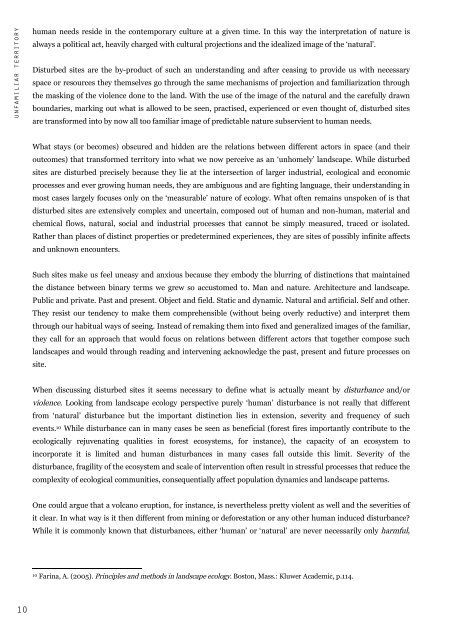Unfamiliar Territory_Research
You also want an ePaper? Increase the reach of your titles
YUMPU automatically turns print PDFs into web optimized ePapers that Google loves.
unfamiliar territory<br />
human needs reside in the contemporary culture at a given time. In this way the interpretation of nature is<br />
always a political act, heavily charged with cultural projections and the idealized image of the ‘natural’.<br />
Disturbed sites are the by-product of such an understanding and after ceasing to provide us with necessary<br />
space or resources they themselves go through the same mechanisms of projection and familiarization through<br />
the masking of the violence done to the land. With the use of the image of the natural and the carefully drawn<br />
boundaries, marking out what is allowed to be seen, practised, experienced or even thought of, disturbed sites<br />
are transformed into by now all too familiar image of predictable nature subservient to human needs.<br />
What stays (or becomes) obscured and hidden are the relations between different actors in space (and their<br />
outcomes) that transformed territory into what we now perceive as an ‘unhomely’ landscape. While disturbed<br />
sites are disturbed precisely because they lie at the intersection of larger industrial, ecological and economic<br />
processes and ever growing human needs, they are ambiguous and are fighting language, their understanding in<br />
most cases largely focuses only on the ‘measurable’ nature of ecology. What often remains unspoken of is that<br />
disturbed sites are extensively complex and uncertain, composed out of human and non-human, material and<br />
chemical flows, natural, social and industrial processes that cannot be simply measured, traced or isolated.<br />
Rather than places of distinct properties or predetermined experiences, they are sites of possibly infinite affects<br />
and unknown encounters.<br />
Such sites make us feel uneasy and anxious because they embody the blurring of distinctions that maintained<br />
the distance between binary terms we grew so accustomed to. Man and nature. Architecture and landscape.<br />
Public and private. Past and present. Object and field. Static and dynamic. Natural and artificial. Self and other.<br />
They resist our tendency to make them comprehensible (without being overly reductive) and interpret them<br />
through our habitual ways of seeing. Instead of remaking them into fixed and generalized images of the familiar,<br />
they call for an approach that would focus on relations between different actors that together compose such<br />
landscapes and would through reading and intervening acknowledge the past, present and future processes on<br />
site.<br />
When discussing disturbed sites it seems necessary to define what is actually meant by disturbance and/or<br />
violence. Looking from landscape ecology perspective purely ‘human’ disturbance is not really that different<br />
from ‘natural’ disturbance but the important distinction lies in extension, severity and frequency of such<br />
events. 10 While disturbance can in many cases be seen as beneficial (forest fires importantly contribute to the<br />
ecologically rejuvenating qualities in forest ecosystems, for instance), the capacity of an ecosystem to<br />
incorporate it is limited and human disturbances in many cases fall outside this limit. Severity of the<br />
disturbance, fragility of the ecosystem and scale of intervention often result in stressful processes that reduce the<br />
complexity of ecological communities, consequentially affect population dynamics and landscape patterns.<br />
One could argue that a volcano eruption, for instance, is nevertheless pretty violent as well and the severities of<br />
it clear. In what way is it then different from mining or deforestation or any other human induced disturbance?<br />
While it is commonly known that disturbances, either ‘human’ or ‘natural’ are never necessarily only harmful,<br />
10<br />
Farina, A. (2005). Principles and methods in landscape ecology. Boston, Mass.: Kluwer Academic, p.114.<br />
10


